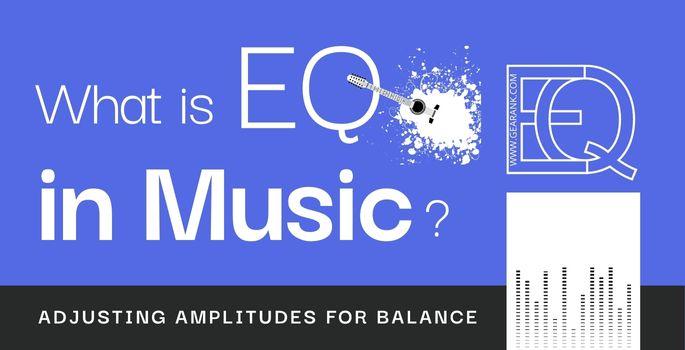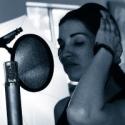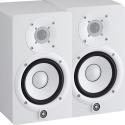What is EQ in Music? The Shape of Your Sound

Equalization is in everything we listen to, so most people know the basic gist of it. But you'll need to go beyond the basics as you get deeper into music production.
Here I'll answer the curious question, "What is EQ in music." And delve into its importance, proper use, and other pertinent details.
What Is Equalization in Music?
There's a high chance that you've already used one. EQ is found in home sound systems, amplifiers, powered speakers, audio streaming services, car audio systems, and more.
You've used equalization whenever you've adjusted the treble or bass in music on your car radio, speaker system, or electric instrument.
Given its extensive use, it's important to learn EQ in detail. From casual music lovers to musicians to music producers - we all can appreciate great-sounding music with well-placed EQ settings.
Knowing how to EQ music is critical in improving your listening and playing experience.
EQ can mean two things:
It could be talking about what is an equalizer: a tool (hardware or software) that lets you control the balance of frequencies in audio signals;
or it could mean equalization, which means manipulating the range of frequencies of an audio signal.
In short, an Equalizer applies equalization to audio.
Equalizers come in hardware or software form. Examples of hardware EQs include EQ guitar pedals, amplifier EQs, and speakers with built-in EQs.
Software EQs include EQ apps and EQ plugins, typically used in music production software.
The Purpose of Audio EQ
Audio equalization has many purposes. But, in short, it's used to improve or change the sound of something to sound good or more suitable for a specific situation.
Equalizers generally boost or cut audio frequencies to shape the resulting sound.
This typically includes raising the treble so you can hear more of the high frequencies or boosting the bass EQ for more bottom end.
We learn this early on while playing around with the controls on audio playback systems.
Using an audio EQ will manipulate the tone of a piece of audio, including the bass frequencies, mid frequencies, and treble frequencies. Use an EQ to boost the bass, for example, or reduce it.
For the average listener, EQ is usually applied to the entirety of the song.
But musicians and sound engineers use EQ more surgically. Different EQ parameters can be applied to specific instruments or certain song parts.
EQ is often used to shape the tone of electric guitars and other instruments. PA systems also use EQ to make different sound sources blend well together.
And it is also a critical component of professional music mixing and mastering.
Sometimes you use EQ to reduce the mids and bass a bit to achieve a specific sound shape or to appease neighbors... (I've been there).
EQ is critical for music producers, audio engineers, musicians, DJs, and other pros. Audiophiles and casual music listeners can also benefit from a well EQ'ed track.
Understanding the Audio Frequency Spectrum
Most people learn to use EQ by trial and error. But it's better to take a more studied approach. One of which is understanding frequency response and the audio spectrum.
This can help you visualize sound shapes better. So you can zero in on the correct EQ settings more efficiently.
The audio frequency spectrum is essentially the entire range audible by human hearing. It's measured in Hz (hertz) and spans from 20 Hz to 20,000 Hz.
Lower Hz determines the low frequencies (bass), while higher Hz determines the high frequencies (treble).
EQ chart is generally split up into frequency components:
- 0-60Hz - sub-bass
- 60-250Hz - bass
- 250–500Hz - low, mid-range (lower mids)
- 500–2000Hz - mid range
- 2000-6000Hz - high mid-range (upper mids)
- 6000-20,000Hz - high end
To list some examples of instruments and frequencies, a kick drum is around 100Hz, the range of an electric guitar is between 80Hz and 1200Hz, and a bass guitar will usually have a frequency range of 40Hz to 400Hz.
Musical notes also correspond to specific frequencies. You can see which frequency each musical note is in by looking at a note frequency chart.
How Does an Equalizer Work?
A typical EQ will have knobs or sliders for specific frequency bands. These can be adjusted to "turn up" (boost) or "turn down" (cut) the frequencies in that band.
Most sound devices come with 2-band or 3-band EQs. Each frequency band has variable frequency gain, measured in dB (decibels). The higher the dB setting, the louder the particular frequency is.
An excellent example is increasing the lower frequencies to get thumping bass sounds.
With the frequency spectrum in mind, some EQs will have more knobs or sliders, meaning more significant control over specific frequencies.
A 30-band EQ, for example, will be able to cut or boost more specific frequencies than a 10-band EQ.
The Different Types of EQ in Music
EQs come in different types, which are used based on ease, functionality, or personal preference.
Analog EQ
Analog EQs are devices that utilize hardware components in applying frequency band changes.
You'll usually see them as part of an amplifier or a processing rack. They offer tactile control over the knobs or sliders assigned to each frequency band.
Analog EQs are great for boosting frequencies because they don't introduce digital distortion. But they could be better at making precision frequency cuts.
Digital EQ
Digital Equalizers apply equalization using digital algorithms. Given their digital nature, Digital equalizers allow for more precise and accurate EQ adjustments.
Digital EQs usually have more flexibility and control options. They can also be packed with features like parametric EQ and high-pass/low-pass filters, bell filter, band stop filters, and more.
As mentioned above, excessive gain increases in a digital EQ can result in unwanted digital distortion.
Parametric Equalizer
A parametric EQ is a digital equalizer, which can be in hardware or software form.
This type of EQ lets you set the center frequency and tweak the frequency bands from narrow bandwidth to wide bandwidth. This allows for more targeted control over the boost or cut of specific frequency bands.
You can use a parametric EQ as a notch filter with the proper settings. You can use it as a shelf filter to cut feedback-prone frequencies, reducing the possibility of acoustic feedback while performing.
They are often used as a DAW (digital audio workstation) plugin.
Graphic Equalizer
A graphic equalizer is a type of EQ that offers better visual monitoring. Instead of knobs, these EQs come with faders.
This setup lets you see the shape of your equalization by looking at the position of the sliders.
An excellent example is the V-shape EQ used in guitars Pop, EDM, and Hip hop also employs V-shape EQ to emphasize the hi-hats and bass drums.
Graphic equalizers come in hardware or software forms.
What Controls Are There on an EQ?
Knowing the various controls that equalizers have is vital to using EQs professionally. You can only get the best sound from your EQ when you know how to set each parameter.
Equalizer settings generally include:
- Frequency gain controls - one for each EQ band
- Master gain control - affects the gain of all frequency ranges
- Q controls - affects bandwidth
The more controls an EQ has, the better it can boost or cut a specific frequency range. Note that while EQ controls affect specific frequencies, the frequencies can effect each other substantially when listened to as a whole. This is why too much bass muddies the treble, and too much treble can make the bass sound thin.
Q control lets you adjust the size (width) of the band, i.e., how many frequencies will be affected. A narrower bandwidth will affect fewer frequencies for a more surgical approach. A wider Q value bandwidth will affect more frequencies, resulting in a more subtle and natural sound.
Some EQs have extra controls like volume level, and filter type selection.
When to Use EQ in Mixing
EQ can be used at various stages, including the recording phase, for mixing and music production, when recording studio equipment is used.
Applying EQ is done by recording engineers to ensure that every audio track is of high quality. It also ensures an audio track sounds clear and doesn't clash with other tracks with the same frequency content. Read more to understand if eq should be before or after compression.
Common uses of EQ in mixing include:
- Making vocals brighter
- Giving snare drums more punch
- Cutting the low end of electric guitars (to give bass guitars more "room resonances" in the mix)
- Reducing high-end vocal sibilance (with the help of a Deesser)
- Eliminating high-frequency noise
How to Use an Equalizer in Music Mixing
The first step to using an EQ in the mixing process is proper routing. Make sure your audio source is going into the EQ.
If you're using a hardware EQ, you'll need to plug the audio source into the input of the EQ.
If you're using a digital EQ, you'll need to set up the EQ as an effect in the correct mixer channel.
The next step is to play the audio (ideally on loop), then adjust the range of frequencies as desired.
You can boost, cut, or eliminate frequencies to make the audio track sound better or clearer. The goal of tone shaping is to make each part fit in the mix better.
Proper balancing of additive EQ and subtractive EQ is needed to achieve this.
Additive EQ, which involves boosting specific frequencies, can make the audio sound louder but muddier in the overall mix.
Subtractive EQ, which involves cutting particular frequencies, can make an audio track fit in the mix more but can negatively impact the tone in music.
Knowing how to use EQ settings in relation to the frequency audio spectrum is just the first part.
Ultimately, surgical EQ in mixing comes down to the human ear: practice, experience, and training your ears for critical listening!
Low Pass Filter vs High Pass Filter
Last, it's worth understanding some equalizers' different filter types.
This includes the high pass vs low pass filter distinctions, also called the high shelf filters vs low shelf filters. These are used to remove unwanted frequencies of low or high bands.
Put simply, a low pass filter will only allow the low frequencies to be heard. A high pass filter, on the other hand, will only allow the high frequencies to be heard.
With low and high-cut filters, you can set a cutoff frequency (or corner frequency) using filter slope controls to cut unwanted frequencies.
For example, you can use a low pass filter on a bass track to ensure that no unwanted high frequencies clash with other audio tracks. Another example is using a high pass filter on drum cymbals to ensure no unwanted lower frequencies conflict with other audio tracks. EQ can also be used to tame unwanted room resonances.
Conclusion
To wrap up, EQ in music can mean either equalizer (tool) or equalization (process).
An Equalizer is an audio processing tool that applies equalization. Equalization is boosting or cutting frequency bands to shape your sound. EQ is used everywhere, in audio recordings, audio tracks, instruments, songs, and more.
Using EQ can positively impact your audio production and casual listening experience.
If you've found this What is EQ in Music Article helpful, you'll enjoy reading our article on Hi-Fi Audio.












